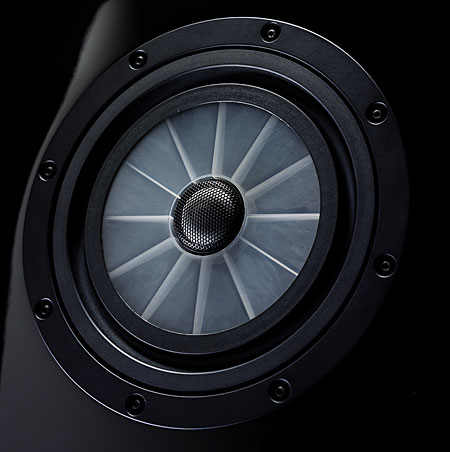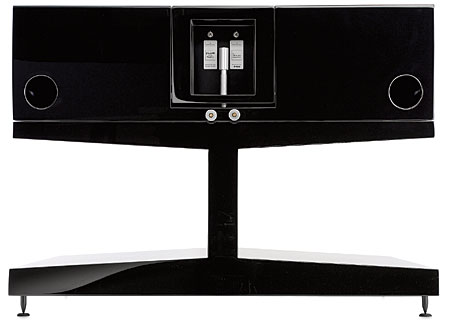Vienna Acoustics Klimt Speaker System Page 2

The coaxial driver rests in its own adjustable subenclosure. You can both swivel the driver and adjust its rake angle toward the listening position regardless of the positioning of the Music’s main cabinet and of the Kiss’ cabinet and stand. This produces great placement flexibility and image optimization, and it allows the all-important midrange driver to be physically decoupled from the bass cabinet’s vibrations. In theory, this should reduce colorations and produce more stable imaging.
Facing the Music
Available in Piano Black lacquer and Sapele veneer finish, the Music is a true furniture-grade product built by an Italian fine furniture manufacturer to Vienna Acoustics’ specs. Despite its imposing size, the stunning curved lines and impeccable finish let the big speaker fit nicely in my moderately sized living room. This was particularly so since I could angle the swivel top that contains the midrange driver and tweeter toward the viewing area, while the main cabinet remained at a 90-degree angle to the front wall. This made for a far neater presentation.
The Music features a column of three 9-inch woofers that work in tandem, in addition to the top midrange/tweeter in its own subenclosure. There’s also a supertweeter that’s mounted at the top of the woofer cabinet. Vienna’s claimed frequency response for the four-way speaker is an ultrawide 22 hertz to 100 kHz. (See HT Labs Measures for our results.)

The Poetry sat in between the pair of Musics on its dedicated stand. It houses a pair of the rearported 9-inch woofers mounted on either side of a coaxial driver for a claimed frequency response of 32 Hz to 20 kHz. It also claims an unusually wide dynamic range for a center-channel speaker. Despite the fact that my sample was finished in stealthy Piano Black lacquer on all sides, I couldn’t help but notice that the Poetry was in the house. It was what most visitors commented on first.

It wasn’t easy to shoehorn both of the Kiss speakers into tight corners at the back of the room. However, the swiveling midrange/tweeter head made it effortless to optimize the sound.
A Pair of REL Subwoofers
For this review, I teamed the Klimt speakers with a pair of REL Britannia B1 subwoofers. They added the foundation to a system that already claimed to be capable of performance below 22 Hz. REL’s flagship Britannia B1 features a forward-firing 12-inch long-throw, dual-ported, bottomvented woofer driven by a 500watt, DC-coupled MOSFET amplifier. Claimed in-room response is a stomach-turning 13 Hz. The front-positioned REL handled the LFE channel, while the surround-channel speaker terminals drove the high-level inputs of the REL that I placed in the rear of the room, to the side of the listening position. This helped to create full-range surround channels.


That’s a Mess of Transducers, but $58k Worth?
Vienna’s setup whiz Patrick Butler dialed it all in, without using electronic room EQ. When you spend this kind of money, you can be sure that Vienna won’t leave you to do it yourself, unless you want to. Otherwise, your dealer will do the setup, hopefully as expertly as Butler did. Don’t even think about getting a system like this without driving it with topgrade electronics. The system sounded good fronted by the Integra DHC-9.9 surround processor, but it really came to life when the Cary Cinema 11a (HT, May 2010) directed. Parasound’s Halo A51 multichannel amplifier provided the power.
In terms of scale, the Klimt array painted an enormous sonic picture and pushed huge amounts of energy through the air toward the listener. Butler played a Bluray Disc of Jeff Beck performing live at Ronnie Scott’s, and the presentation was effortless. The ease with which the system produced the deepest, pitch-correct electric bass notes and the most intense cymbal crashes and woody rim shots put this system in a league of its own. It easily competed with my two-channel rig in all of the parameters I hold fundamentally critical, thanks in part to the uncompressed, lossless audio we’re now so lucky to have with Blu-ray. Spatially, this recording’s surround sound was far more enveloping than two-channel sound and easily put you in the club. With big, full-range surrounds, the sensation of full envelopment in the environment went from suggested to undeniable. I cranked the volume to center-front-table nightclub levels. The system’s dynamic capabilities—combined with its wide-range frequency response and enormous sense of scale—induced first immersive physical awe and then laughter as all of my senses became overheated and then overwhelmed.





























































